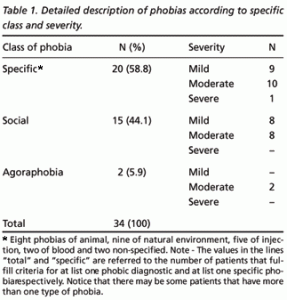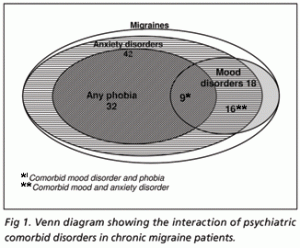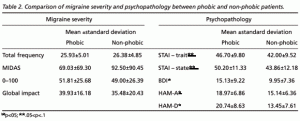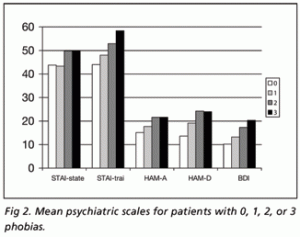Fobias, outras comorbidades psiquiátricas e enxaqueca crônica.
Arq. Neuro-Psiquiatr. vol.64 no.4 São Paulo Dec. 2006
Felipe Corchs; Juliane P.P. Mercante; Vera Z. Guendler; Domingos S. Vieira; Marcelo R. Masruha; Frederico R. MoreiraI; Marcio Bernik; Eliova Zukerman; Mario F.P. Peres

RESUMO
INTRODUÇÃO:
As comorbidades psiquiátricas das enxaquecas crônicas são bem conhecidas. As fobias, transtorno ansioso mais comum, são mais prevalentes entre enxaquecosos do que entre não enxaquecosos. O perfil clínico de fobias em uma população enxaquecosa nunca foi estudado.
MÉTODO:
Estudamos aspectos psiquiátricos de uma população de 56 pacientes com enxaqueca crônica.
RESULTADOS:
Usando o SCID I/P para o DSM-IV, critérios diagnósticos para ao menos algum transtorno psiquiátrico durante a vida foram preenchidos por 87,5% de nossa amostra, 75% para ao menos um transtorno ansioso e 60,7% para condições fóbicas em algum momento de suas vidas. Os escores de ansiedade e humor foram maiores entre os fóbicos e o número de fobias teve correlação positiva com o grau de ansiedade e depressão.
CONCLUSÃO:
Fobias são comuns na enxaqueca crônica e seu reconhecimento poderia influenciar seu manejo e melhorar seu prognóstico.
Palavras-chave: cefaléia, enxaqueca, ansiedade, fobia.
ABSTRACT
BACKGROUND: Comorbidity of chronic migraine (CM) with psychiatric disorders, mostly anxiety and mood disorders, is a well-recognized phenomenon. Phobias are one of the most common anxiety disorders in the general population. Phobias are more common in migraineurs than non-migraineurs. The clinical profile of phobias in CM has never been studied.
METHOD: We investigated the psychiatric profile in 56 patients with CM using the SCID I/P interview.
RESULTS: Lifetime criteria for at least one mental disorder was found in 87.5% of the sample; 75% met criteria for at least one lifetime anxiety disorder and 60.7% of our sample fulfilled DSM-IV criteria for lifetime phobic avoidant disorders. Mood and anxiety scores were higher in phobic patients than in non-phobic CM controls. Number of phobias correlated with higher levels of anxiety and depression.
CONCLUSION: Phobias are common in CM. Its recognition may influence its management. Early treatment may lead to better prognosis.
The importance of psychiatric comorbidity in migraine has long been recognized1,2. There is a growing body of evidences that they may share diverse epidemiological, pathophysiology, and treatment response aspects3. Among psychiatric comorbidities, those with mood and anxiety disorders are the most common. Anxiety disorders are common in episodic migraine patients but even more frequent in chronic migraineurs4. Somatic complains are common among anxious subjects, mostly tachycardia, dyspnea, gastrointestinal discomfort, and muscular pain. Headaches can also be part of these unspecific somatic manifestations. On the other hand, migraine and anxiety may be more closely related than just unspecific somatic complains5,6. Merikangas et al.5, in a prospective study, found anxiety disorders to be more frequently comorbid with migraine than affective disorders. They also suggest that migraine with anxiety and depression may constitute a distinct syndrome comprising anxiety, the primary phenomena, often manifested in early childhood, and followed by the occurrence of migraine headaches, and then by discrete episodes of depressive disorder in latter adulthood. In other study, phobias in adolescents and young adults were outstanding predictors of latter, incident migraines7.
Anxiety disorders also greatly increase the use of medical resources in migraine patients, with higher annual direct costs (12,642 US$ vs 5,179 US$)8 in the United States of America. In addition, anxiety disorders creates additional decreases in quality of life levels in chronic migraine patients9. According to the DSM-IV10, anxiety disorders encompass several conditions including: generalized anxiety disorder (GAD), panic disorder (PD) and agoraphobia, posttraumatic stress disorder (PTSD), social phobia (SP), specific phobia, obsessive-compulsive disorder (OCD) and the less clearly defined mixed anxiety-depressive disorder. Phobias are the most common anxiety disorder in the general population, the lifetime prevalence has been found to be up to 12.5% in specific phobias and 13.0% in social phobia, which is one of the most common psychiatric condition11-13; up to 23% if child life simple phobias are included. Phobias are more common in migraineurs than non-migraineurs; the clinical profile of phobias in CM has never been studied.
In this paper we report on a systematic investigation on the clinical aspects of the comorbidity of phobias in CM patients and their relationship with other psychiatric comorbidity.
METHOD
Fifty-six patients with CM according to the International Headache Society criteria (IHS)14 were selected for this study (51 women, 5 men, aged 24 to 64 y. mean ±sd 41.69±11.71). Chronic users of acute migraine medication that did not fulfill criteria for medication overuse headache (MOE) were also included in the study. Doubtful cases were excluded.
Headache disability was measured by the Migraine Disability Assessment (MIDAS)15, a 0 to 100 visual analogue impact scale (0 meaning the highest impact and 100 no impact) assessing the amount of disability caused by headaches along the month (global) and during the attack. Total headache frequency was also ascertained.
Psychic profile was assessed by the SCID 1/P16, a structured interview for psychiatric disorders based on the DSM-IV diagnostic criteria10, and applied by a trained clinician. We further evaluated intensity of depressive symptoms with the Hamilton depression rating scale (HAM-D)17 and the Beck depression inventory (BDI)18. The intensity of anxiety symptoms was assessed by the Hamilton rating scale for anxiety (HAM-A)19 and the Spielberger state-trait anxiety inventory (STAI)20.
The research protocol was reviewed and approved by the Hospital Israelita Albert Einstein Committee of Ethic in Research. All subjects signed written consent forms prior to assessment.
Statistical analyses were performed to investigate possible differences in headache characteristics and in anxiety/ depression scores in patients with phobias versus those without phobias. The number of patients with a mood disorder (major depressive episode and/or dysthymia) was calculated in those with and without phobias. The anxiety and depression levels were also compared.
The Fishers exact and the Students T-test were used for the analysis. Results were considered significant when P <.05 but trends of P <.10 were also reported. All tests were two tailed. Data were processed with the statistical package SPSS 10.0 for windows (SPSS, Chicago, Illinois).
RESULTS
Forty-nine patients (87.5%) of our sample met criteria for at least one lifetime mental disorder. Sixteen subjects (28.6%) fulfilled criteria for major depressive disorder, one for dysthymia, 2 for bipolar disorder and 3 for grief. Two patients met criteria for an eating disorder and 4 for alcohol and/or non-alcoholic substance use disorders. Forty-two subjects (75%) of our sample presented at least one lifetime anxiety disorder. Twenty-five subjects (44.6%) fulfilled criteria for GAD, one for PD, one for OCD, and 3 cases for PTSD. The phobic conditions are fully described in results.
Thirty-four patients (60.7%) of our sample fulfilled DSM-IV diagnostic criteria for a phobic anxious condition (social, specific, or agoraphobia) in their lifespan. At the moment of the evaluation, 20 (35.7%) patients had a diagnosis of specific phobia, 15 (26.8%) social phobia, and 2 agoraphobia. Four patients had a history of phobic conditions in the past but did not fulfilled criteria for these conditions at the moment of the evaluation (one specific, one social and two agoraphobia). Details upon prevalence, type and severity of phobias are presented on Table 1.
Interactions among phobias, mood disorders, and non-phobic anxiety disorders, proved to be complex with high levels of comorbidity. These interactions can be well visualized in the Venns diagram below (Fig 1).

When phobic patients are compared with non-phobic patients, headache severity levels did not differ between the groups (Table 2) 

DISCUSSION
Despite of the importance of phobic disorders and the avoidant behaviour characteristic of phobic-anxious conditions, among psychiatric comorbidities observed in migraneurs, very little was studied about this issue. One study evaluated the personality of patients with headaches, demonstrating that patients with migraine and tension type headache scored higher on harm avoidance factor of personality than did controls21, even though this finding was not confirmed by other authors22. According to Cloningers theory23, harm avoidance would be a heritable temperament trait related to inhibition of behaviours, such as pessimistic worry and passive avoidance behaviours, such as fear of uncertainty and shyness.
Radat et al.24 pointed a greater incidence of psychiatric disorders among migraneous patients that chronically used substances compared with patients without that history. In this study, two of the three most frequent diagnosis observed were anxious conditions and the other one was major depressive disorder, which was frequently accompanied by anxiety symptoms, such as fear and avoidant behavior. In a prospective evaluation of this cohort, the authors found important longitudinal comorbidity between anxious disorders and migraine. However, in logistic regression models including age, sex, and psychiatric illness in 1981, only phobia was predictive of future migraine7.
The present study provides more insight into the understanding of a yet unexplored matter on migraine field: the phobic-anxious aspects. A trend, a phobic-anxious trait of personality, or a psychiatric (anxiety) disorder might play a role in the process of migraine chronification. A comparison, for example, of the rates of specific phobias in our sample (31.82%) with the prevalence of phobias in the general population (12.5%)11-13, seems to show a trend of higher levels of phobias in CM then in the population as a whole.
A preliminary understanding of this relationship is provided by behavioral theories. A core feature of phobic-avoidant disorders is the anticipatory anxiety, a state of preparation for an imminent or likely threat. Subjects with a high level of trait anxiety tend to be more sensitive to potential threats or to the aversive nature of anticipatory anxiety. These subjects may develop avoidant behaviors to keep them away from those stimuli or aversive emotional states. This could explain, at least in part, why some patients take hold of analgesics in the least warning of pain. If so, we could be looking for a sub-group of CM patients with poorer prognosis, making their headaches worse by overusing acute medication. Fear of having a headache attack or worsening a baseline headache in daily sufferers may start a behavior of analgesic intake or decrease the threshold of analgesic utilization25.
It must be clear, however, that definitive conclusions about the role of phobias in favoring chronicity and/or overuse could be drawn only by directly comparing frequency of headache with the use of acute migraine medication. In spite of the design of the present study do not allow this direct conclusion, we can observe that the more phobias patients present, the higher the levels of anxiety and depression in CM patients. It has been recognized that they deserve special psychiatric attention, but a focus on phobic aspects may influence its management and eventually treatment response. Although there is a lack of evidence to support any recommendations when phobias and migraines are related, it is clear that treating the phobic condition is a key point as to avoid the overuse of analgesics. Psychological interventions may be outstanding on the maintenance of the abstinence of analgesics. Treatment of phobias in CM may lead to lower level of anxiety and depression and a better quality of life.
REFERENCES
PARA ACESSAR O PDF CLIQUE EM:
https://cefaleias.com.br/wp-content/uploads/2009/07/fobiasmedosenxaqueca.pdf

